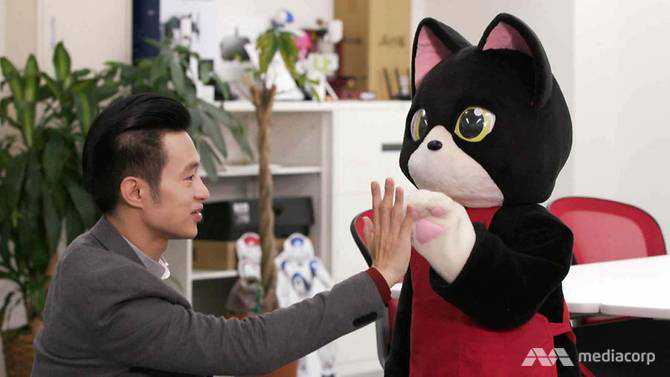It's cats and T-rex versus humanoids, as robots take over jobs in Japan
31 January, 2018

JAPAN: As the founder of Robot Technology Corp, Ms Yukiko Nakagawa believes that the only way robots can become man’s best friend is if they look like animals instead of humans.
“Human-like robots are eerie … (They) have doll-like expressions,” she said. “If we put human skin on a robot, and it works well, humans will see it as a rival (for jobs).”
One of her most successful robots is the cat-shaped robot Nekotencho, which can be seen greeting customers outside the company’s retail shop at the world-famous electronics town Akihabara.
“When you think of cats, you can (accept) their strange behaviour – jumping, dancing and many other strange behaviours. It’s the same for this cat robot,” said Ms Nakagawa, who has devoted her life to the robotics industry.
“(But) if this robot had a human-like appearance, you’d (expect) that it behaves like a human, for example, to speak very cleverly and (function) very well.”
Japan has long been at the forefront of robotics - it has the most robots in the world and is set to invest ¥100 billion (S$1.2 billion) in robotics research.
In 10 to 20 years’ time, half of the country’s working population could be replaced by robots or artificial intelligence programmes.
And if the ones that can move and think like humans are going to do a lot more of Japan’s jobs, what will they look like?
While people may think these are personal choices, the programme Why It Matters discovers that robot appearances are built based on common biases, as people have specific ideas about how their robot replacements should look like.
DINOSAURS MANNING THE COUNTER
For example, at Tokyo’s Henn-na Hotel, the world’s first robot-run hotel – with the largest concentration of robots in a single hotel – guests are checked in by teeth-baring velociraptor robots manning the front desk.
Receptionist and robot resource manager Saki Kato - one of the few human staff at the facility - spoke about the need to have robots as co-workers as the population and the number of working adults in Japan decreases.
She also suggested that guests’ responses to the dinosaur robots have been largely positive.
“The raptors are more popular than the humanoid,” she said. “We’re humans, and we see humans every day. We’ve never seen real dinosaurs … Everyone loves dinosaurs.”
Except maybe the children.
“When the automated doors open, the children cry when they see the Tyrannosaurus rex robot. Some even said they’d rather stay outside the hotel,” she laughed.
Still, some roboticists think robots need not look like humans to bridge the gap between man and machine. This is because of the Uncanny Valley, a concept coined by roboticist Masahiro Mori.
He held that as robots become almost human-like, people develop a sense of unease about them, but that their feelings change if the robot is exactly like a human.
THE MORE HUMAN, THE BETTER?
Mr Takashi Minato, one of the programmers at the Intelligent Robotics Laboratory in Osaka University, the leading robot laboratory in Japan, thinks it is important for a robot communicating with humans to look like one too.
“You can’t have a natural conversation with a speaker or a smartphone … A human-like appearance results in a different experience in the conversation,” he said.
One of the lab’s most impressive robots is Erica, a humanoid that is able to engage people in conversation. It speaks in a synthesised voice, can make various facial expressions and gestures like a person.
Erica can be put to work as a receptionist at a hotel or hospital or even as an English teacher.
“In a conversation between two humans, we get a lot of information from the person’s gaze, expressions or gestures,” said Mr Minato. “Robots like Erica are a kind of bridge between humans and devices.”
Over in Singapore, Professor Nadia Magnenat Thalmann, the director of the Institute for Media Innovation at Nanyang Technological University (NTU), would rather interact with a human-like robot than any random-shaped one.
One of her creations is social robot Nadine, made in her likeness. It was developed in 2015 as part of a project to address manpower needs in the administrative and healthcare sectors.
“If we need partners in life to help us … it’s very important that they look like humans and function exactly like humans,” said Prof Thalmann.
GENDER STEREOTYPES IN ROBOTS
For Professor Tatsuya Nomura from Ryukoku University’s Department of Media Informatics, the bigger problem is not the debate about how human robots should look; it is about the gender stereotyping of robots.
Having spent decades studying the relationship between man and machines, he believes that the assignment of gender to robots is a controversial issue because it may produce gender stereotypes.
(Japanese) have a stereotype that receptionists should be female … But receptionists needn’t be female.
"A male can also conduct the tasks of a receptionist,” he said. “This type of gender stereotype can cause similar problems in every country.”
“Some robotics designers use these gender stereotypes (when they design robots) in order to smoothen the interaction between humans and robots. This is because these gender stereotypes reduce our communicative burdens,” he noted.
In other words, making robots human-like and gendered could trap men and women in the stereotypical roles from which these robots could free them.
In Singapore, the lifelike Nadine is now working as a receptionist in NTU. When asked if this reinforces gender stereotypes, Prof Thalmann said receptionists are women in most cases, but that a male receptionist robot should perhaps be made next.
“We should educate people. We should take this opportunity to have maybe mostly female security guard robots,” she added.
“We should just make the contrary of (what) it is today … Then people get educated. It’s also a way to change the stereotypes and not continue them.”
